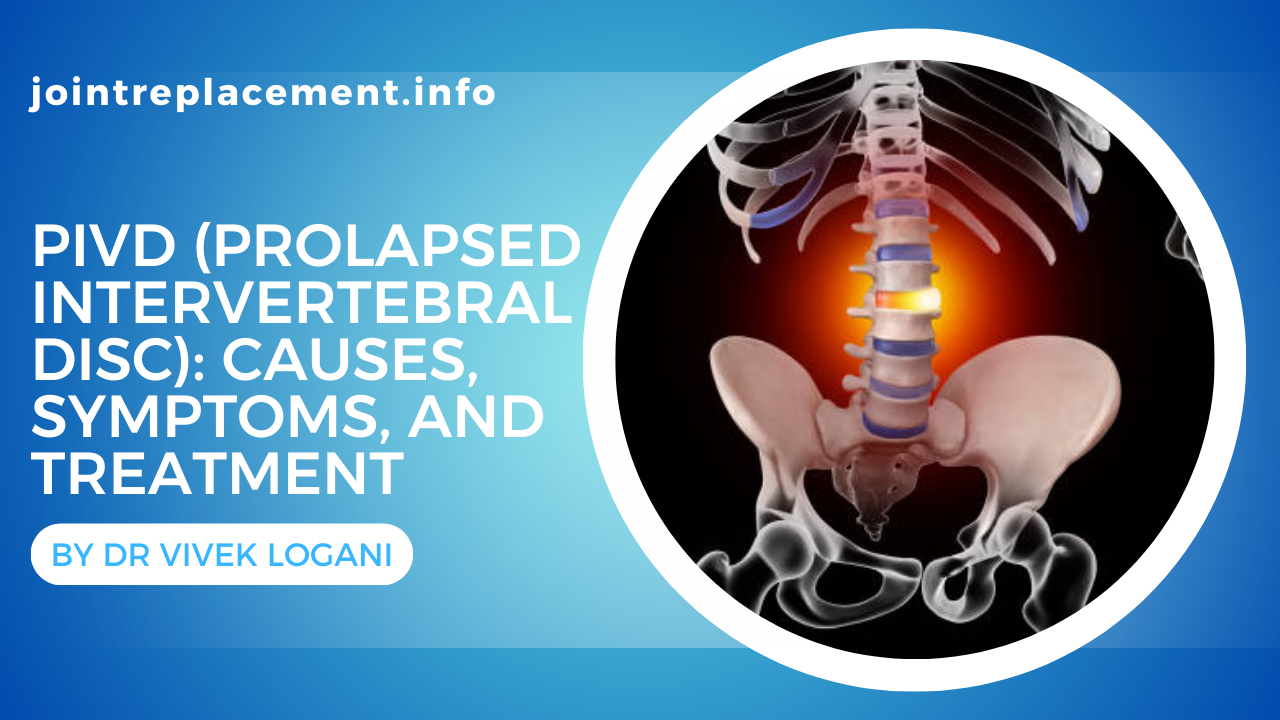Introduction
The human spine is a complex structure composed of vertebrae, discs, nerves, and muscles that support the body. A common spinal issue is PIVD (Prolapsed Intervertebral Disc), which occurs when a disc between the vertebrae bulges out, leading to pain, discomfort, and mobility issues. This condition can affect anyone, but it is more prevalent in individuals who have a sedentary lifestyle or engage in strenuous physical activities.
Dr. Vivek Logani, Director – ORTHOPAEDICS, specializes in diagnosing and treating PIVD, helping patients regain mobility and lead a pain-free life.
Understanding PIVD (Prolapsed Intervertebral Disc)
What is PIVD?
PIVD is a condition where the soft cushion-like disc between two vertebrae slips out of its position. This can lead to compression of the spinal nerves, causing pain, weakness, and numbness in different parts of the body.
Causes of PIVD
Several factors contribute to PIVD, including:
- Aging – Natural wear and tear of the spinal discs over time.
- Injury or Trauma – Accidents or falls can cause disc displacement.
- Repetitive Strain – Repetitive heavy lifting or sudden movements.
- Obesity – Excess weight puts additional strain on the spine.
- Poor Posture – Sitting for prolonged periods in incorrect posture.
- Genetics – Some individuals are genetically predisposed to disc issues.
Symptoms of PIVD (Prolapsed Intervertebral Disc)
The symptoms of PIVD vary depending on the severity and location of the affected disc. Common symptoms include:
- Lower back pain – Often radiating to the legs.
- Neck pain – If the cervical spine is affected.
- Numbness or tingling – Common in the arms or legs.
- Muscle weakness – Difficulty in lifting objects or walking.
- Reduced flexibility – Stiffness and difficulty in bending or twisting.
- Pain worsening with movement – Especially when sneezing or coughing.
Diagnosis of PIVD (Prolapsed Intervertebral Disc)
Dr. Vivek Logani uses a combination of clinical evaluation and imaging tests to diagnose PIVD. The diagnostic process includes:
- Medical History & Physical Examination – Understanding the symptoms and examining the spine.
- MRI (Magnetic Resonance Imaging) – Provides detailed images of the spinal discs.
- X-rays – Helps rule out other spinal conditions.
- CT Scan – In cases where MRI is not possible.
- Nerve Conduction Studies – Determines the severity of nerve compression.
Treatment Options for PIVD (Prolapsed Intervertebral Disc)
Non-Surgical Treatments
Most cases of PIVD can be managed with conservative treatments, including:
- Medications – Anti-inflammatory drugs, pain relievers, and muscle relaxants.
- Physiotherapy – Strengthening exercises to improve posture and spinal health.
- Lifestyle Modifications – Maintaining a healthy weight and avoiding heavy lifting.
- Epidural Steroid Injections – Reduces inflammation around the affected nerve.
- Heat & Cold Therapy – Helps in relieving pain and inflammation.
Surgical Treatments
Surgery is considered when conservative treatments fail. Surgical options include:
- Microdiscectomy – Removal of the herniated portion of the disc.
- Laminectomy – Removal of a portion of the vertebra to relieve pressure.
- Spinal Fusion – Fusing two or more vertebrae to stabilize the spine.
Dr. Vivek Logani specializes in minimally invasive spinal surgeries, ensuring faster recovery and minimal complications.
Recovery & Rehabilitation
Recovery from PIVD prolapsed intervertebral disc varies based on the severity and treatment method. Key aspects of recovery include:
- Physical Therapy – Essential for regaining strength and flexibility.
- Posture Correction – Avoiding positions that strain the spine.
- Gradual Return to Activity – Avoiding sudden movements or heavy lifting.
- Regular Follow-Ups – Monitoring recovery progress with the doctor.
Preventing PIVD (Prolapsed Intervertebral Disc)
Prevention is crucial in reducing the risk of PIVD prolapsed intervertebral disc. Here are some preventive measures:
- Exercise Regularly – Strengthening back and core muscles.
- Maintain a Healthy Weight – Reducing strain on the spine.
- Practice Good Posture – Keeping the spine aligned while sitting and standing.
- Avoid Heavy Lifting – Using proper techniques to lift objects.
- Take Breaks – Avoid sitting for long periods without movement.
Conclusion
PIVD (Prolapsed Intervertebral Disc) can significantly impact a person’s quality of life, but with timely diagnosis and appropriate treatment, recovery is possible. Dr. Vivek Logani, Director – ORTHOPAEDICS, offers expert guidance and advanced treatments to help patients manage and overcome this condition effectively.
By following preventive measures and adopting a healthy lifestyle, individuals can reduce the risk of developing PIVD prolapsed intervertebral disc and maintain optimal spinal health.
For expert consultation and advanced treatment options, reach out to Dr. Vivek Logani, a leading specialist in spine care.
